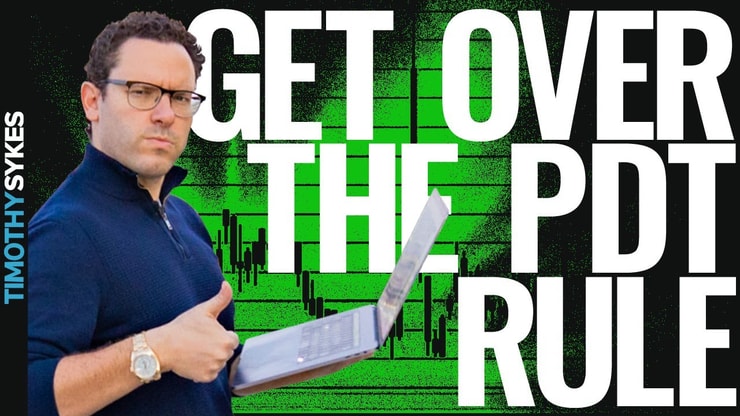Do you know all the stock trading rules and regulations that can impact your trading?
If you don’t, start learning now.
Stock trading rules affect the number of day trades you can make, the types of patterns you can trade, and the strategies you can use.
So don’t wait until you lose money — or worse, have your account locked — to learn them.
Learn these rules before you start trading. When you know what they are, you can make your own trading rules.
In this post, I’ll break down the stock trading rules and regulations you need to know and how they can affect your trading. Plus, I’ll show you why you need your own stock trading rules and share some of my stock trading rules to live by.
Let’s do this!
Table of Contents
What Are Stock Trading Rules?

2025 Millionaire Media, LLCThe most well-known day trading rule for accounts under $25,000 is the pattern-day trader (PDT) rule.
It restricts the number of day trades you can make with a small account. It only affects traders who trade through margin accounts.
Cash accounts aren’t subject to the PDT — but they take more time for funds to settle. That could restrict the number of trades you can make if you use a large portion of your account in each trade.
More on the PDT rule shortly … If you want to know more about margin requirements, go to the FINRA site.
Day Trading Rules Over $25K
There are no day trading limits if you keep at least $25,000 in your margin account.
But as soon as you take a few losses and your account goes down to $24,999.99 … Yep, you’re subject to the PDT.
SEC Day Trading Rules
The SEC approved the FINRA pattern day trader rule in 2001 after the dot-com bubble burst and many amateur traders and investors took huge losses.
FINRA created the rule in an attempt to protect new and uneducated traders.
More Breaking News
Pattern Day Trading Rule
The PDT rule restricts traders to three day trades per rolling five-day period.
It only affects traders with less than $25,000 in a margin account. Because of the rules restricting day trading, many new traders wonder…
“Is pattern day trading illegal?”
Not in the sense that you’ll go to jail for doing it. But your broker can freeze your account for up to 90 days if you break the rule. If that happens, you’ll have to wait it out, fund your account with $25,000, or open and fund a new account.
A lot of traders hate this trading rule. I think it’s great.
It helps prevent new traders from overtrading. There’s no reason to be in and out of positions all day. You should focus on finding your best setups and growing your account with small gains over time.
I always encourage new traders to start small. Even if you have enough funds to start with $25,000, don’t risk it all. Start with $2,000 or $5,000.
Better yet, paper trade before you put your hard-earned money at risk.
StocksToTrade has an awesome paper trading feature. You can customize it to match your real account size and commission structure.
I love StocksToTrade because it’s specifically designed for trading penny stocks. It has awesome charts, built-in scans, watchlists, and social media feeds. And its Breaking News Chat add-on feature alerts me to breaking news FAST. It also has broker integration so you can research stocks and trade on one platform.
Get a StockToTrade 14-day trial for only $7 or get it with the Breaking News Chat for only $17!
(Quick disclaimer: I proudly helped design and develop StocksToTrade and am an investor in it.)
Can You Buy a Stock and Sell It the Next Day?
Buying a stock one day and selling it the next isn’t considered a day trade. You can make unlimited overnight trades, even with a small account.
That’s why patterns like my first green day OTC work great for traders starting with a few thousand dollars. You could make five overnight trades a week and still have three day trades.
Many of my Trading Challenge students are under the PDT. That’s why I teach patterns and strategies you can use to potentially grow a small account over time.
It takes a lot of discipline. You can’t let emotions affect how you trade. And that’s where your rules come in … They can help you stay focused on your risk and your goals when you’re in a trade. But you must be disciplined enough to follow them…
Learn to embrace trading rules. If you trade without them, you’re gambling.
You have to accept the regulatory stock trading rules — and your own rules — for each trade. Here are some of mine…
5 Stock Trading Rules to Live By

2025 Millionaire Media, LLCMany traders ignore rules and lessons until they start losing money. Then they quickly realize how important they are.
Rules aren’t fun, but they’re essential. They help protect your account when a stock goes against you. And they can help you focus on the best setups, and can prevent overtrading.
You don’t have to be smart to make it in this game, but you MUST be disciplined.
Here are my stock trading rules to live by…
1. Study the Market
All my top students have a passion for the markets. You have to love it. Almost to the point of obsession.
You need to have a hunger for knowledge. A curiosity for what makes stocks move the way they do. And why some have potential, while others don’t.
Then you have to study your butt off. Knowledge doesn’t come overnight. There’s a reason most of my millionaire students are in year three or four of their trading journeys.*
It takes thousands of hours of watching charts in real time to get a feel for price action. So don’t try to rush success. You don’t even have to trade in the beginning…
Watch the market while studying my thousands of video lessons on Profit.ly, all my DVDs, and my 1,400+ videos on YouTube.
(*Please note that these kinds of trading results are not typical. Most traders lose money. It takes years of dedication, hard work, and discipline to learn how to trade. Individual results will vary. Trading is inherently risky. Before making any trades, remember to do your due diligence and never risk more than you can afford to lose.)
2. Use the Right Broker
When it comes time to trade, you need the right broker to execute your trades. I use E-Trade and Interactive Brokers. That’s not because they’re the best … they just suck the least for my needs. They work for me and my trading style.
Find the one that works best for you.
If you want to trade OTCs or short sell penny stocks, you’ll need a broker that allows that and has good executions. Do your research before you deposit any money.
I’d avoid trading apps like Robinhood and Webull. I don’t think they give you the best options for day trading low-priced stocks.
Don’t use an offshore broker in an attempt to get around the PDT rule. It’s an unnecessary risk. Next…
3. Have a Plan
A trading plan is imperative to trading success. Without it, you’re gambling. And you’re more likely to let emotions take over, which leads to mistakes.
You should have a plan before you risk any money.
Use my Sykes Sliding Scale to prepare for every trade. I go over all seven of my trading indicators in detail in my “Trader Checklist Part Deux” DVD. Some don’t even have to do with the stock or patterns. You have to consider how other factors, like your trading psychology, can affect your performance.
The most important part of your trading plan should be to…
4. Cut Losses Quickly
Cutting losses quickly is my #1 rule. It’s the best way to protect your account.
Risk management is a must.
I cut losses so fast sometimes I don’t even wait for a loss. If a stock doesn’t do what I want or does something unexpected — I get out. I don’t care if I only make 1% on the trade. I’m not going to wait for a loss to cut a trade that’s not doing what I expect.
Losses are part of trading, but cutting them quickly can keep them small.
Your trading plan shouldn’t only include a plan for cutting losses. You also have to learn to…
5. Sell Into Strength
You should have a goal for your trades — where you’ll take profits.
Learn to sell into strength. Go for singles. Don’t swing for home runs.
Once a stock is doing what you want it’s easy to think, “I’ll just hold a bit longer,” trying to get more out of the trade. Don’t get greedy. Take profits along the way.
It’s OK to sell too soon, but it’s not OK to overstay.
My top students and I don’t catch the bottom and top of every move. I almost always sell too soon. But if you follow this trading rule, your small gains can add up over time.
Take my former Trading Challenge student turned Challenge chat room moderator Matthew Monaco. He’s now a millionaire trader. His average gain is roughly $1,300 per trade.* But that’s added up to over $1.5 million in trading profits.*
I teamed up with Matt to create my 30-Day Bootcamp for new traders. It’s a month’s worth of lessons with daily assignments and homework. Bonus: It comes with “The Complete Penny Stock Course” book and my “Pennystocking Framework” DVD. And you get all three for under $100. Get in my Bootcamp now!
The Stock Trading Rules Conclusion
It’s important to educate yourself on all the stock trading rules and regulations. Ideally, you do that before you start trading. Once you’re trading, you can make your own smart rules.
Your trading rules should align with your trading style, patterns, and personality. They can help you trade to your strengths and minimize mistakes.
Too many traders make mistakes and lose a ton of money before they realize the importance of trading rules. You don’t have to learn the hard way…
You can learn all the stock trading rules I teach my students in my Trading Challenge. I’ve learned my rules through trial and error over my 20+ years in the market.
If you’re accepted into my Challenge — and not everyone is — you’ll get access to thousands of video lessons and all my DVDs. Plus, you get my weekly live trading and Q&A webinars and over 1,000 archived webinars from me and multiple top traders with years of experience.
Becoming a self-sufficient trader isn’t easy. It takes a ton of hard work, time, and dedication. But it can be so rewarding if you stick with it.
Ready to get started? Apply to my Trading Challenge now.
What are your top stock trading rules? Let me know in the comments … I love to hear from you!















Leave a reply